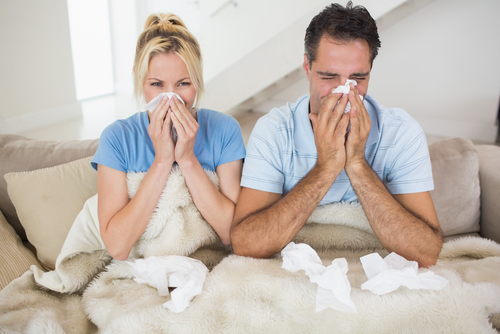BLOG
Allergies Getting to You? Check Your Indoor Air Quality
 America has a huge indoor air quality problem. Modern humans spend 80-90 percent of their time indoors these days, breathing air that is often more contaminated than the air they’d breathe walking down a busy city street.
America has a huge indoor air quality problem. Modern humans spend 80-90 percent of their time indoors these days, breathing air that is often more contaminated than the air they’d breathe walking down a busy city street.
Poor indoor air quality can play a major role in the onset and/or worsening of allergies and respiratory disorders, and if anyone in your family is struggling with these problems your “home sweet home” may be the source of the trouble.
Why is Indoor Air Quality So Poor?
You can’t see the pollutants you’re breathing in inside your home, but they are everywhere. On a daily basis, your respiratory system is bathing in a noxious stew of dust, dirt, smoke, mold spores, cobwebs, decaying newspapers or magazines, gasoline fumes from adjacent roads or garages, pet dander, pollen, chemical traces from cleaning products, and particulate matter emanating from bathrooms and kitchens.
Needless to say, the potential of these contaminants to provoke allergic attacks is immense. If, while relaxing in the comfort of your own home, you’ve ever experienced itchiness and irritation of the eyes, nose or throat, hopelessly clogged nasal passages and/or runny nose, rashes or hives, lightheadedness, or a constriction of the throat or lungs that made breathing difficult, you may very well have been feeling the effects of polluted indoor air.
Fortunately, there are a number of steps you can take to improve the indoor air quality in your home and protect yourself against the impact of allergies.
Five Strategies for Indoor Air Quality Improvement
To enhance the breathability of your home’s air, here’s what you need to do:
1. Use high-quality HVAC air filters
Good air filters with MERV ratings of 11-13 can remove a substantial portion of the contaminants that provoke allergies and other respiratory conditions. Rather than purchasing cheap fiberglass filters, you should choose pleated filters or electrostatic filters, which last longer and perform much better.
2. Improve your ventilation
The options for improving air flow in your home include:
- Opening windows and installing screen doors so you can open doors as well
- Placing fans in or near windows, drawing air in on one side of the home and blowing it out on the other (to create refreshing cross-breezes)
- Turning on kitchen and bathroom fans, even when those rooms aren’t in use
- Installing a whole-house fan, which will do an outstanding job of ventilating and cooling your home
- Removing or relocating any objects that might be blocking air flow through windows
- Installing fresh air and exhaust vents in bedrooms and living rooms
3. Installing air cleaners
The two most effective types of air cleaners for the removal of particulate matter are mechanical air filters and electronic air filters. Trained HVAC technicians can install them so they interconnect with your HVAC ductwork, or you can purchase table top models to help you keep specific rooms free and clear of contaminants.
4. Control your home’s humidity levels
High humidity can spur the growth of mold and trigger allergies or asthma, while low humidity can cause dryness and itchiness of the eyes, nose, throat and skin. Ideally, the relative humidity inside your home should never rise above 50 percent in the summer and shouldn’t drop below 25 percent in the winter, and you may have to purchase a dehumidifier and/or a humidifier it you have trouble hitting these targets.
5. Keeping your ducts clean
HVAC ductwork can easily become dirty or contaminated with bacteria or mold, both of which thrive in moist locations. And when your air conditioner is running, everything gets stirred up and much of it ends up passing through vents and into the rooms you occupy—and from there, directly into your lungs.
To combat this problem, you should have your ducts professionally cleaned on an annual or every-other-year basis. UV lamps that kill mold and bacteria can also be installed in your ductwork, and these handy devices do an excellent job of wiping out nasty biological contaminants.
Northern Climate Control Restores Indoor Air Quality
If you live in the Denver Metro Area and need products or advice to improve your indoor air quality, please contact us at Northern Climate Control right away. We can help you develop a comprehensive plan of attack to prevent bad indoor air quality from damaging your family’s health, and as a licensed and insured HVAC contractor we can also provide you with a full range of important services, including duct sealing and repair that can prevent your ductwork from becoming contaminated.



